Our Garden | An Update

Vegetable gardening! I receive THE MOST questions about our garden this time of year, and since our gardening story is unique, and my approach to gardening is super chill, and I figured I’d go ahead and write an updated post on the topic. You can see my past garden posts here (my last update was from June 2017, so I have lots to share). Get a cuppa your favorite beverage, and prepare to read a short book!

Why a Garden?
- I so highly recommend gardening for everyone; regardless of your level of experience or the amount of dirt you have at your disposal, it’s incredible to witness the life cycle of a plant. Gardening, especially when you are planting from seed, is so fulfilling and enjoyable; there’s a certain magic in growing things, and anyone can do it! I cannot keep houseplants alive, but my outdoor plants thrive!
- Growing [at least some] of your own food is the ultimate exercise in slow living. It teaches that with a little hard work, patience, and diligence, you will reap glorious results! But it takes time and doesn’t happen overnight, just like the slow living lifestyle.
- Being a part of the process, and being able to grow enough fresh things to provide for your family and share with neighbors, is a HUGE blessing. Sharing with others has been so incredible; our neighbor Harold eagerly awaits tomato harvesting season; we’ll share peaches and herbs with Julie and her family as the season progresses; Joe’s family will stop by for greens and tomatoes. We may even set up a little vegetable “stand” at the end of our driveway this year, depending on the harvest!
- It’s been so fun teaching our children about gardening; the hard work it entails, the highs and the lows, about seeds and germination and what a plant needs to grow, about food security, and SO MUCH MORE! Gardening has been such a fun part of our homeschooling, and will continue to be for years! I’ll hopefully be sharing a post about our family time in the garden soon!
- Regardless of your level of commitment or the season or your access to dirt, you can almost always grow something. Herbs in a window box. Microgreens on your kitchen counter. Tomatoes in pots on the deck. Strategically placed plants utilizing a small patch of soil alongside the house. A few pots on your apartment rooftop. Or a sprawling garden out back.

A Bit About Our Vegetable Garden
Now that we’ve covered some of the why, let’s talk about our vegetable garden! We moved into our home in the fall of 2013. Over the first four summers, we slowly expanded our vegetable garden. Currently, we have three 20′ x 8′ raised beds, which are situated end-to-end. They’re along the back border of our yard, which we love because we always chat with our neighbors when we’re in the garden. We started out with one 8′ x 20′ raised bed in 2015, then in 2016 we increased it to two, then in 2017, we increased it to 3. Somewhere along the way, we built a compost bin (I’ll talk more about that in another post), and planted 5 fruit trees. Only 3 of our fruit trees remain (1 peach and 2 cherries; our other peach and apple tree were destroyed by disease and Japanese beetles), but we’re hopeful for these 3!

How We Made Our Raised Beds
To make the raised beds, we simply turned over all the grass in the area where we wanted the raised bed to live and then we let it sit for a few days. After that, we tilled it (yes, we are aware of the no-till method, but haven’t used it yet in our gardens), and added compost. We are considering switching to the no-till method, but haven’t yet, primarily because we didn’t have enough organic material to cover our gardens sufficiently. Then Joe build the wooden sides for the raised beds, and we added loooots of compost.
That’s Joe’s number one gardening tip: Add new organic material to your garden every single year.

Frequently Asked Gardening Questions
“Why a raised bed?”
Well, it just seemed right for us at the time when we were just starting out, and it’s continued to work! There’s a lot less weeding and maintenance; it’s already contained. But there are other methods that work for other people. We have plenty of neighbors who plant directly into the ground, with no containment or borders.
“What do you do about weeds?”
Almost everything in our garden is planted in rows, spaced about 10″ – 12” apart. To weed, I take the flat hoe and gently scratch at the dirt in between the rows. The plants usually drown out the weeds in the actual rows. If I see large weeds I usually pull them out. If I see anything obnoxious while out harvesting, I’ll pull it out, but I typically only weed about once per week.
“What do you do about pests?”
We haven’t had a TON of pest problems. One year, our squash crop was destroyed by squash bugs (but they came in on the plants we bought at the nursery, and we’ve just avoided squash since then. One year, all our sweet peas were eaten (maybe by bunnies); I’m going to attempt growing them on a trellis this year. Joe planted mint in the small area between each 20′ raised bed to help keep pests away. And that’s it! Some plants will go to the pests, and that’s just something to accept in pesticide-free gardening.
“What is your planting schedule?”
Ha, I don’t have one!! Seriously though, I thought I would be a meticulous garden planner, that I’d draw diagrams of the garden and figure everything out perfectly. But when it came down to it, that’s not my personality. I don’t even draw, so why did I think I’d draw pictures of my garden? I buy seeds of things I’d like to grow, and then in the early spring, I head back to my garden, sit in the grass, and figure out what needs to be planted when. This will be our first year where I plant more than once! I typically just plant in spring, and we harvest everything until it stops. This year I am planning on planting multiple times. So far, I’ve had several planting sessions, and hope to continue throughout the summer, late summer, and maybe even again in the early fall.
“What do you grow?”
I should really do a separate blog post on this, but typically here’s what we grow: rapini, radishes, LOTS OF GREENS (arugula, kale, chard, collards, romaine, spinach, etc), herbs (basil, thyme, marjoram, rosemary, lavender, chamomile, etc.), scallions, chives, leeks, cauliflower, carrots, turnips, and some others I’m probably forgetting about!
“Do you rotate your crops?”
We aren’t obsessive about rotating, but generally, you don’t want to plant the same crops in the same zone repeatedly because crop-specific diseases and pests can build up and poison the plants. We’re roughly on a three year rotation (since we have three 20′ sections of garden). One thing I’m working on is separating all my leafy greens to keep the bugs from moving from one to another; we had annoying kale bugs last year that went from the kale and then on to other greens. If you have a raised bed, it’s not as crucial to rotate because you’re – hopefully – adding in new organic material to raise the soil level every spring.
“Is it too late to start a garden?”
NO! It’s never too late to start with something! If it’s winter, grow something on your countertop! Springtime is for planting lettuces, radishes, greens, etc. In the summer, grow vegetables that need solidly warm weather (like sweet potatoes, sweet peas, beans, okra, squash, eggplant, melon, etc.). Lots of greens, radishes and turnips, and rutabaga will do great with a second planting in the late summer (about 90 days before first frost). I’ll be planting garlic for the first time this fall, for harvesting next summer! If you do a little research, you can come up the perfect – simple – plan for starting growing something RIGHT NOW!

My Favorite Gardening Supplies
This is a question I’m asked about quite frequently! I think having the right supplies is crucial; it makes the job easier and more enjoyable. Our most-used tools were collected over the years from auctions, but I’ll link to some comparable ones online! Here are a few of mine and Joe’s favorite tools and supplies to use in our vegetable garden:
- STRAIGHT HOE: I use this primarily for weeding between rows; I lightly scrape it between rows and it digs up an small weeds without me having to bend over for hours;
- GARDEN RAKE: for smoothing compost/dirt and “sifting” weeds out from garden bed;
- WEEDER: I never used one of these until I met Joe, and it’s THE BEST tool for getting weeds OUT, especially when dandelions are taking over the garden (just putt ’em out and eat ’em);
- TROWEL: for weeding/digging small holes for plants;
- SHOVEL: for turning over soil;
- GLOVES: I don’t always wear them, but when I do, I like this style; the finger tips are thinner and allow a lot of mobility;
- GARDEN BAG: My number one best friend in the garden. It’s my emergency toolkit; I keep it in the garage, and it holds everything I need. Every time I head out to the garden, I grab my bag. It holds my seeds, string, row markers (I just use popsicle sticks), trowel, weeder, permanent marker, hammer, scissors, gloves. Keeping this bag stocked and grabbing it when I head back to the garden saves me a million trips back and forth for something I forgot; everything I need is in the bag.

Favorite Gardening Clothes
- Loose, breezy button up tops that cover my back and shoulders
- Apron
- Hat
- Gloves
- Boots (blundstone)
- Harvest bag for produce (market basket bag or a tote)

Miscellaneous Tips and Tricks
- Don’t overthink your garden and get paralyzed by worrying about planning everything in advance. I thought I’d be a planner, and trying to plan kept me from actually ding anything. Just start it and learn as you go. Take notes, keep a gardening journal, keep track of the layout, where you planted things each year, what you planted, what works and what didn’t work. It’s awesome and fun, but don’t overthink it. Have a rough, loose plan, but don’t over-plan if you’re the type to get overwhelmed and then get paralyzed from the overwhelm.
- Don’t try to do too much. The year we tripled our garden, I wanted to do all the things, so we planted TONS of kale, lettuce, chard, and spinach. Suddenly, we had lots of fresh greens and we weren’t able to use all of them and I was overwhelmed. There’s so much joy and satisfaction in just having a few things in your garden. You may not have time or energy for a full garden. You can just grow fresh herbs in a window box. They’ll make your food delicious, and give you a sense of pride, joy, and fulfillment.
- Plant what you know you’ll love, maybe what you can’t get anywhere else. You can grow just a few things and it will still make a difference in your day to day life.
- If you have no experience gardening, start small and simple. It depends on where you live and how much space you have. If you have yard space and sun, maybe do a small raised bed and just plant your five favorite plants. It’s easier to buy plants from a garden store instead of starting from seed. If you don’t have space, you can do container gardening or a window box.
- If you’re beginning or overwhelmed, don’t think you have to start everything by seed. I never start my tomatoes or my herbs from seed. In fact, I never start anything from seed indoors. I just kill them, and that’s ok. Maybe one day I’ll have space for an indoor grow light, but for now, I only start seeds outside. This does limit me in what I’m able to grow from seed myself. But I’m 100% buying a handful of plants from the local nursery! Learning your capabilities and accepting your limitations is soooo important when gardening.
- I love gardening in the evening, either before or after dinner. The sun is cooler then, and it’s just really lovely to spend the latter portion of your day digging in the dirt.

Our Favorite Things to Grow
- Asparagus: this is a wonderful surprise after the long winter, and it’s ready to harvest before anything else in the garden;
- Radishes: they are ready to harvest a lot quicker than other root veggies, and everyone LOVES them;
- Rapini: this is our first year growing it, and we LOVE it;
- Arugula: this is a simple, low maintenance green; it’s very tasty raw or sautéed or tossed into soup;
- Herbs: lemon thyme, chives (our first year growing them…hoping for some blossoms); basil (alllll the pesto);
- Tomatoes: our tomatoes always do soooo well and we’re always able to share, which is so rewarding! Cannot wait for later this summer!
Leave a Reply
PREVIOUS POST:
NEXT POST:
Disclosure.
Discovering how to infuse our lives—ourselves, our work, our relationships, our homes, and our entertaining spaces—with simple beauty, more intention, and slow living principles.
Interested in working together?
Click here to visit the Contact page and get in touch.
PORTFOLIO
© 2020 A Daily Something — All Rights Reserved.
Design by TONIC.
Learn more about A Daily Something styling services, content creation offerings and view curated work.
CONTACT + COLLABORATE
MANIFESTO
Join the list to receive our thoughtful monthly letters, and to be the first to know of upcoming workshops, dinners, gatherings, and more.
SUBSCRIBE
ALL PHOTOS AND IMAGES ON A DAILY SOMETHING ARE BY A DAILY SOMETHING UNLESS OTHERWISE NOTED. IF YOU SEE AN IMAGE THAT IS NOT PROPERLY SOURCED, PLEASE LET US KNOW AND WE'LL UPDATE THE INFORMATION! IF YOU WOULD LIKE TO SHARE A PHOTO OR TUTORIAL FROM A DAILY SOMETHING, PLEASE ONLY SHARE ONE PHOTO, WHICH MUST BE CREDITED AND LINKED BACK TO A DAILY SOMETHING.
SPONSORED POSTS WILL ALWAYS BE DISCLOSED AND ANY GIFTED ITEMS WILL BE MARKED C/O. WE ONLY WORK WITH COMPANIES THAT ARE A GOOD FIT FOR THE A DAILY SOMETHING AESTHETIC AND CONTENT. THANK YOU FOR SUPPORTING THE COMPANIES THAT ENABLE US TO CONTINUE PRODUCING QUALITY CONTENT.
What a joy to see your garden. We’ve just started our first garden this year, and I can 100% relate on being so overwhelmed with over planning. I finally closed all the books and decided I’d just read the backs of the seed packs and try my best. When I run into a problem, I’ll seek answers, but all the advise and must do’s were so stifling I thought there’s simply no way I can ever measure up.
Ps. I’m very happy to report we are experiencing more success (so far) than I ever dreamed we would see.